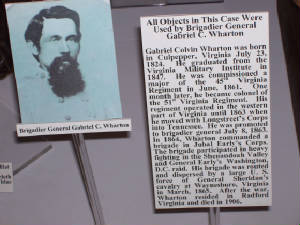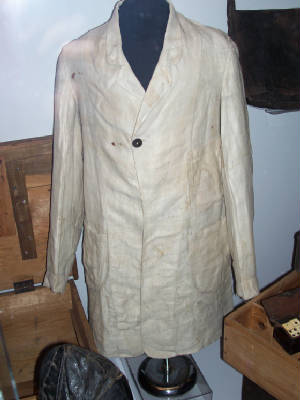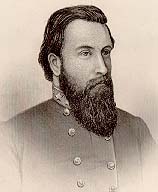|
Brigadier General Gabriel Colvin Wharton
(July 23,1824 - May 11, 1906)

|
| Confederate General Gabriel C. Wharton |

|
| Brigadier General Gabriel Colvin Wharton's Display, photographed by the writer |

|
| Civil War Coat Duster |
(Left) Brigadier General Gabriel Colvin Wharton's Coat Duster at the Texas Civil War Museum.
Photographed by the writer, all photos courtesy Texas Civil War Museum*.
Gabriel C. Wharton, VMI Class of 1847
| General Gabriel C. Wharton |

|
| (Courtesy VMI) |
Biographical Information
- Early Life
Gabriel Colvin Wharton, born July 23, 1824, Culpeper, Virginia.
- VMI record
Enrolled at VMI on September 1, 1845; was graduated on July 5, 1847, standing 2nd in a
class of 12 (distinguished graduate).
- Marriage
Married Nannie Radford in 1863. One son, William.
- Pre-Civil War
Civil Engineer in west (Arizona and elsewhere).
- Civil War
Colonel, 51st Virginia Infantry Regiment; served in Floyd's western Virginia campaign; appointed
Brigadier General Sept. 1863; commanded brigade guarding railroads in southwestern Virginia; fought at New Market, Cold
Harbor, and in Valley Campaign.
- Post-war
Civil Engineer in southwestern Virginia; instrumental in building railroad in New River Valley;
died May 11, 1906, at Radford, Virginia; buried Radford.
Brigadier General Gabriel Colvin Wharton was elected major of the Forty-fifth Virginia Infantry Regiment in July 1861. This
was one of the regiments organized by General Floyd in southwest Virginia. A month later he became colonel of the Fifty-first
regiment, which he led through the Western Virginia campaign of General Floyd during the summer and fall of 1861. Accompanying
Floyd to Kentucky early in 1862, he was assigned at Fort Donelson to the command of a brigade composed of his own and the Fifty-sixth Virginia
regiment. In his report of the battle, General Pillow particularly commended the gallantry of Colonel Wharton and his brigade,
who, after being under fire or fighting in the ditches four days, advanced and drove the enemy from their front on February
15th. On the next day, surrender having been decided upon, a considerable part of Floyd's command was brought away in safety,
and Wharton rendered valuable service in preserving the government stores at Nashville. Subsequently, returning to southwest
Virginia, he defeated a Federal regiment at Princeton, May 17, 1862, and in September participated in Loring's occupation
of the Kanawha valley, as commander of the Third Brigade of the Army of Western Virginia. Subsequently, he was in command
at the Narrows of New River with his own and Echols' Brigade, until February 1863, when he was stationed in the area
of Abingdon, Virginia. When Gen. Sam Jones was ordered in July to send troops to Lee's army, Wharton was detached, and Jones sent word to Lee, "He is an admirable
officer, has commanded a brigade for eighteen months, Let him command my troops until I come." He was stationed at Winchester,
and was temporarily in charge of the Valley District. Soon afterward he was promoted brigadier-general and in August returned
to his former station on the Virginia & Tennessee railroad. He was later transferred to General Longstreet's
command in East Tennessee, until April 1864, when he was ordered to report to General Breckinridge. In command of his brigade of veterans he took a conspicuous part in the defeat of General Sigel at New Market,
and served with honor in the Confederate lines at Cold Harbor. Returning toward the southwest for the defense of Lynchburg, he took part in
the pursuit of Hunter down the valley and the expedition through Maryland to Washington. During the Shenandoah Valley, he commanded a division comprising the infantry brigades of the old army of
Western Virginia. After suffering severely during the valley battles of 1864, the division was badly cut up in the fight at
Waynesboro, March 2, 1865. After the close of the war General Wharton lived at Radford.
For a portion of the Valley Campaigns of 1864, General Wharton was Thomas Legion's division commander. When Thomas' Legion received Special Order 267 ordering its
return to western North Carolina in December 1864, General Wharton stated to the Thomas Legion that "The patience and cheerful endurance of the toilsome march, brief
rests and hard fighting which you and your gallant band ever exhibited has won
my hearty commendation and leaves each of your patriotic command a record bright
and unsullied." While serving with Wharton in the valley, the Thomas Legion had engaged Generals Sheridan and Custer. Wharton,
a VMI graduate in 1847, had gained the respect of the legionaries, with many of the legion's men speaking highly of Wharton in their memoirs.
*The Texas Civil War Museum, located in Fort Worth, is the
largest Civil War museum west of the Mississippi. The museum hosts a massive
collection of Civil War artifacts and, ranging from numerous types of guns to parts from the USS Harriet Lane to a few hundred
Antebellum dresses, it is ideal for the entire family. With a professional theater, visitors can even relax in comfort and
watch a short video on Texas and the American Civil War.
Sources: Virginia Military
Institute; Confederate Military History, Vol. III, pp. 684-685; Vernon H. Crow, Storm in the Mountains: Thomas' Confederate Legion of Cherokee Indians and Mountaineers, 102-58; Official Records
of the Union and Confederate Armies; Texas Civil War Museum.
Recommended Reading: Four Years in the Stonewall Brigade (American Civil War Classics) (412 pages) (University of South Carolina Press). Description: From his looting of farmhouses
during the Gettysburg campaign and robbing of fallen Union soldiers as opportunity allowed to his five arrests for infractions
of military discipline and numerous unapproved leaves, John O. Casler’s actions during the Civil War made him as much
a rogue as a Rebel. Though he was no model soldier, his forthright confessions of his service years in the Army of
Northern Virginia stand among the most sought after and cited accounts by a Confederate soldier. First published in 1893 and
significantly revised and expanded in 1906, Casler’s Four Years in the Stonewall Brigade recounts the truths of camp
life, marches, and combat. Moreover, Casler’s recollections provide an unapologetic view of the effects of the harsh
life in Stonewall’s ranks on an average foot soldier and his fellows. Continued below...
A native of Gainesboro, Virginia, with an inherent wanderlust and thirst
for adventure, Casler enlisted in June 1861 in what became Company A, 33rd Virginia Infantry, and participated in major campaigns
throughout the conflict, including Chancellorsville and Gettysburg.
Captured in February 1865, he spent the final months of the war as a prisoner at Fort
McHenry, Maryland. His postwar narrative recalls the
realities of warfare for the private soldier, the moral ambiguities of thievery and survival at the front, and the deliberate
cruelties of capture and imprisonment with the vivid detail, straightforward candor, and irreverent flair for storytelling
that have earned Four Years in the Stonewall Brigade its place in the first rank of primary literature of the Confederacy.
This edition features a new introduction by Robert K. Krick chronicling Casler’s origins and his careers after the war
as a writer and organizer of Confederate veterans groups. "A must have for researchers, buffs, and American historians...General
"Stonewall" Jackson and his brigade shall forever have a place in the annals of world history."
Advance to:
Recommended Reading:
The Stonewall Brigade, by James I. Robertson (Author) (304 pages) (Louisiana State University Press). Description:
Commanded by Thomas J. Jackson and comprised of the 2nd, 4th, 5th, 27th and 33rd Virginia Infantry Regiments, plus the Rockbridge
Artillery Battery, the unit was officially Virginia's First
Brigade. This changed forever at the Battle of First Manassas when in the face of a seemingly
overwhelming Federal attack, General Bee, an adjacent Confederate brigade commander, reportedly said, "Yonder stands Jackson
like a stone wall; let's go to his assistance. Rally behind the Virginians!" Continued below.
This book describes the
Stonewall Brigade in combat from first mustering to bitter end, when only 210 ragged and footsore soldiers remained of the
6,000 that served through the war. Absolutely a must read for the Civil War buff!
Recommended Reading: Battles and Leaders of the Civil War, Volume
6 (Battles & Leaders of the Civil War) (632 pages) (University
of Illinois Press). Description: Sifting carefully through reports from newspapers, magazines, personal memoirs, and
letters, Peter Cozzens' Volume 6 brings readers more of the best first-person accounts of marches, encampments, skirmishes,
and full-blown battles, as seen by participants on both sides of the conflict. Continued below.
Alongside the
experiences of lower-ranking officers and enlisted men are accounts from key personalities including General John Gibbon,
General John C. Lee, and seven prominent generals from both sides offering views on "why the Confederacy failed." This volume
includes one hundred and twenty illustrations, including sixteen previously uncollected maps of battlefields, troop movements,
and fortifications.
Recommended
Reading: Rebels and Yankees: Commanders
of the Civil War (Hardcover), by William C. Davis (Author), Russ A. Pritchard (Author). Description: Davis and Pritchard have created a wonderful work that is sure to become a hit with anyone who studies the Civil War.
This book uses words and a generous amount of pictures and photographs to
tell the story of the leaders, both talented and flawed, that held together the two struggling armies in a time of chaos and
devastating loss. Continued below...
Although many
of the stories have been told in one form or another....Commanders compiles this study in a single book that makes
it very easy to compare and contrast the styles and techniques employed by officers of both armies. I thoroughly enjoyed the
book and highly recommend it.
Recommended Reading:
Young Lions: Confederate Cadets at War. Description: "In making soldiers of them," said Confederate president Jefferson
Davis regarding the mobilization of his nation’s youths, "we are grinding the seed corn." Yet, the bloody millstones
of war ground them--and nowhere more noticeably than at the Confederacy’s de facto "West Points." The legend
of the Southern cadets is one of "untrained boys wastefully flung in the path of Yankee armies as the Confederacy came to
a turbulent end." The reality, however, is one of highly trained young men who rendered valuable service from the earliest
days of the war and, when confronting the enemy on the battlefield, acquitted themselves as well as veteran troops did. Continued
below...
The Young Lions: Confederate Cadets at War is the story of the Southern cadets at four major military colleges
during the Civil War—the Georgia Military Institute, the South Carolina Military Academy (Columbia’s
Arsenal campus and the Citadel in Charleston), the University
of Alabama, and the Virginia Military Institute. It is also the story
of the Confederate government’s lack of a cohesive policy toward military colleges and its failure to adequately support
the institutions that fostered its officer corps. This study is the first thorough examination of the interrelationships and
common challenges of the South’s major military colleges, giving a detailed history of these Southern institutions.
James Lee Conrad discusses the cadets’ day-to-day lives as well as the academic and military systems of the schools.
From the opening of the Virginia Military Institute in 1839, through the struggles of all the schools to remain open during
the war, the death of Stonewall Jackson, and the Pyrrhic victory of the Battle of New Market to the burning of the University of Alabama,
Conrad reveals the everyday heroism of cadets both on and off the battlefield.
|

